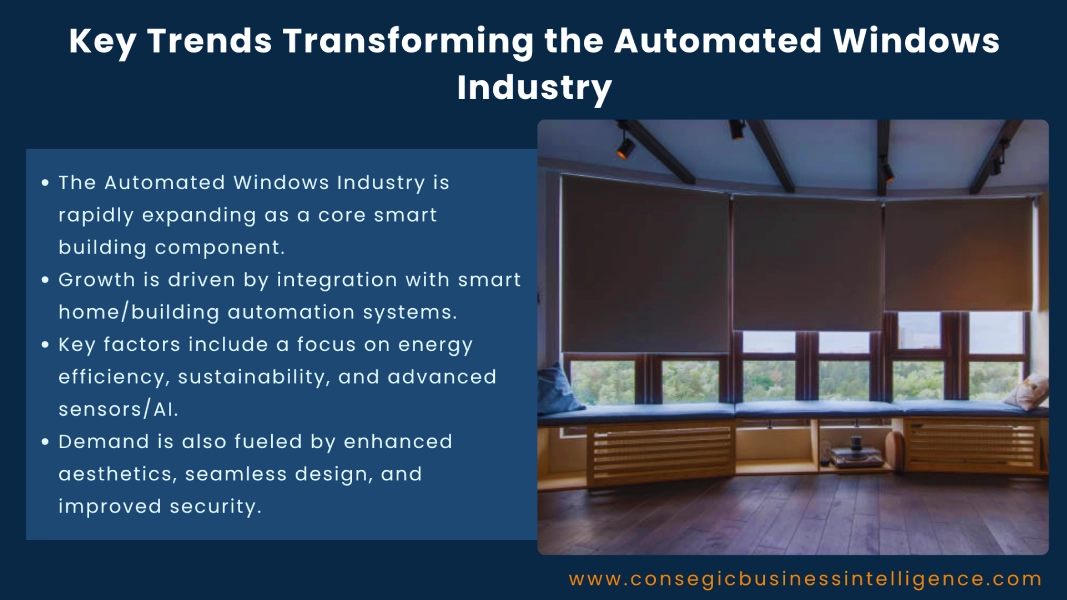Key Trends Transforming the Automated Windows Industry
The Automated Windows Industry is developing rapidly due to its use as an essential component of smart and modern buildings. The automated windows market is expected to experience significant shifts, propelled by integration with smart home and building automation systems. Furthermore, the emphasis on energy efficiency and sustainability, advancements in sensor technology and artificial intelligence (AI), enhanced aesthetics and seamless design integration, and demand for enhanced security features has fueled its demand.
This blog overviews the key trends driving the automated windows industry and how advancements support the rising need for an intelligent, energy-efficient, and secure working environment.

- Integration with Smart Home and Building Automation Systems
One of the most transformative trends in automotive windows is its integration with smart home and building automation systems. Consumers and the managers of commercial property are looking for centralized control and seamless connectivity throughout various functions of the buildings. These windows are intelligent components that generally connect with Heating, Ventilation, and Air Conditioning (HVAC), lighting, security systems, and climate control platforms, thereby enhancing their performance and functionality. In addition, the employment of Internet of Things (IoT) devices and advanced communication protocols such as Zigbee, Z-wave, Wi-Fi, and others in automated windows has enabled this convergence, thus allowing easy control of the automated window through smartphones and voice commands.
- Emphasis on Energy Efficiency and Sustainability
The rise in awareness about environmental factors, along with the growing requirement for sustainability, influences the automated windows market. Smart window systems are used to enhance climate control by managing ventilation and light exposure, thereby reducing the reliance on artificial heating and cooling systems. These windows are integrated with advanced systems such as IoT sensors that monitor weather conditions, such as temperature, humidity, intensity of sunlight, and the CO2 level. They also consist of open and closed window mechanisms that actively perform these functions depending on the environmental conditions. This control significantly minimizes wastage of energy, lowers the utility bill, and leads to overall sustainability. As the mandates for energy saving and green building certification are becoming prevalent, the requirement for automated windows for achieving energy efficiency is growing rapidly.
For instance, Volkswagen ID.7 features a smart panoramic roof that can switch from transparent to opaque, based on the outside weather and climate conditions, enhancing passenger experience and comfort, along with vehicle energy efficiency.
- Advancements in Sensor Technology and Artificial Intelligence (AI)
Innovations in technology, such as IoT and artificial intelligence, are creating a positive impact on the automated windows industry. Integration of these technologies in the automated windows facilitates their easy and efficient use. The systems consist of sensors that collect data in real time based on the environmental conditions both inside and outside the buildings. For example, the rain sensors close the window automatically during precipitation, whereas the light sensors enhance daylight, eliminating the need for artificial lighting. This predictive capability of automated windows goes beyond simple automation by intelligent and effective weather prediction.
For instance, the Impact Window Group incorporated AI and IoT in automated windows, allowing facial recognition of people entering the building premises. This enables precise control over who enters the building by cross-checking it in the database. If the person has not previously entered the premises, their face, along with other information, will be added to the database. This minimizes the continuous checking of people who frequently enter a residential building, thus simplifying the work and enhancing security.
- Demand for Enhanced Security Features
Along with the major function of automated opening and closing the window, the system incorporates advanced security features, such as the detection of an obstruction in the window's path using sensors, forcing it to stop and prevent accidents. In addition, the ability to control and monitor the status of the window remotely using mobile applications allows users to verify whether the windows are locked from a distance. Such high security features in the automated windows are significantly driving its market.
For instance, IKEA has introduced smart security features in the automated opening and closing of the window, including motion and object detection, all of which are notified to the user through the IKEA Home app, enhancing user experience and performance of the automated windows.
- Enhanced Aesthetics and Seamless Design Integration
Modern infrastructure focuses on the aesthetics and integration of novel designs. The automated windows industry is keeping up with this trend by developing streamlined minimalist designs that match perfectly with contemporary building finishes. Various manufacturers are providing a wide range of materials, finishes, and motorization options that perfectly fit within window frames.
For instance, according to 3D Windows, the minimalist frames and maximized glass are currently in trend. With slim frames and expansive glass frames, it maximizes natural light, offering an unobstructed view. Moreover, this window design offers a modern look to homes as well as uses the window space efficiently.
Conclusion
The automated windows industry is undergoing a dynamic transformation. The combination of smart home and building automation, the growing need for energy efficiency, advancements in technologies, enhanced security features, and the continuing demand for aesthetics and design integration are the trends that are collectively driving the market. In addition, the growing environmental concerns and innovations in technology influence the automated windows market, paving the path for efficiency and sustainability.
